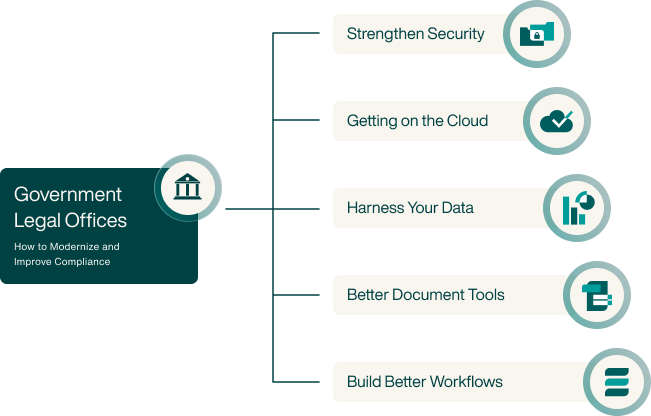The work of government legal professionals is crucial. But often, you’re doing it under tremendous pressure. You’re expected to comply with a long list of regulations and solve complex problems in areas of law that change rapidly. At the same time, you’re dealing with limited resources and budget uncertainty—and unlike your colleagues in the private sector, you can’t just pick and choose your clientele or your caseload.
Fortunately, modern tools can help. Case management for government legal offices can help you stay on top of deadlines, comply with regulations and ethical duties, and accomplish more work with less.
As you advocate for the interests of the public, you deserve the best tools at your side. Here are 5 ways to modernize your practice as a government legal professional:

1. Strengthen Security at Your Firm
Recent ransomware and espionage attacks have hit some of the most prominent government law offices in the country, including US federal prosecutors in New York, Los Angeles, Miami, Washington, and more. While these massive data breaches made front-page news, even the smallest government legal departments are targeted by nefarious actors.
Make sure that your tools and practices comply with stringent security protocols. In addition to auditing your in-office practices, ask each vendor you work with to demonstrate that they perform regular audits and comply with the latest iteration of the CJIS Security Policy.
This is also a great time to fully update your office’s Disaster Recovery and Business Continuity plan. Consider the new threats you face, but also the new technologies at your disposal to continue your important work even in a crisis.
2. Use Document Automation Tools
Government legal departments spend a tremendous amount of time creating, archiving, retrieving, and compiling documents. You can save significant time — and improve accuracy — by using modern automation tools.
Automatic document generation tools pull information directly from your files to create personalized documents. Each time you retype or manually alter a document, you not only waste time—you increase the likelihood of human error. Automatic document generation helps you to create polished documents rapidly, which adhere to the high standard and professional voice your office requires.
Better organization tools also help you stay on top of discovery. With mountains of information coming your way, you need help organizing, sharing, and annotating the right files. Optical Character Recognition (OCR) makes any image or PDF searchable, allowing you to find anything you need.
Document management tools can also enable you to gather eSignatures through text, to help your matters move forward without interruption.
3. Get On A Cloud-Based Management System
The cloud also allows better collaboration between members of your team. It’s the easiest way to communicate with your team across distance, share documents and notes, assign tasks, and make sure everyone has the latest updates.
Read our blog to find out the Best features of a Cloud Base Management System
When all your information is centralized on the cloud, it’s easier to conduct conflict checks and comply with other requirements. Secure, cloud-based tools are also your best weapon to ensure resilience in the face of uncertainty. With all your information on a cloud-based case management system, you can continue your work from any device, anywhere. With one sign-in, your home becomes your office.
4. Build Efficient and Automated Workflows
Many government legal departments find their workload is growing, but their budget isn’t. To do more with less, they’re looking to tools and practices that maximize efficiency.
Taskflow automation is one of these. Legal case management software like Filevine allows you to map out your deadlines and routine tasks to create customized taskflows.
As soon as one task is completed, the next is automatically assigned to the right person, ensuring that matters move forward and nothing falls through the cracks. Features like deadline chains help you map out each step of your work, staying well ahead of pending deadlines.
Look for tools with fully customizable project phases and workflows. You want to ensure that you can match the needs of your specific area of work, even if that changes over time.
5. Harness Your Case File Data
Your data holds the key to greater performance. It can show where you’re succeeding and where you’re falling behind. It can show whether you comply with regulations and your office’s obligations and also help you diagnose solutions to your problems.
But you can only benefit from your data if you record and analyze it. Centralized legal case management software eliminates the need for redundant data entry — it pulls information directly from your files and your activity within the platform.
With data analysis tools, you can track your costs and budgets. You can analyze the performance of different team members to find bottlenecks, distribute work fairly, and reward those who bring good outcomes. Any piece of information you’re recording in your files can be analyzed, revealing the challenges and opportunities your office is facing.
Look for tools to generate charts and graphs from your data quickly. The visual form helps you grasp your data more fully and also communicates performance and needs to your team and your broader constituency.
__________
Tools that improve your efficiency and keep you compliant quickly pay for themselves. At a time when government legal departments of all levels are facing unprecedented challenges, you deserve the tools that will help you modernize your work and comply with new mandates and regulations.

